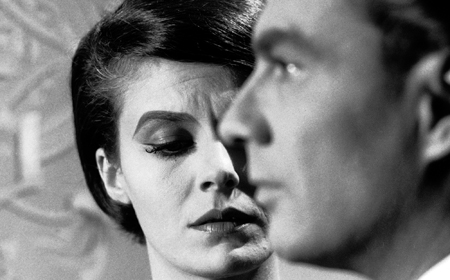
“OPEN
TO INTERPRETATIONâ€
By
Raymond Benson
Last Year at Marienbad should have had the marketing tagline: “Open to Interpretation,†for the film belongs
at the top of a list entitled Movies That Make You Go ‘Huh??’
Alain
Resnais’ enigmatic, surreal, and puzzling experimental picture from 1961, the
follow-up to his acclaimed Hiroshima mon amour (1959), won the Golden
Lion at the Venice Film Festival. The picture has been simultaneously praised
and reviled since its release because audiences generally don’t know what to
make of it.
Yes,
it’s beautiful to look at. The cinematography by Sacha Vierny is magnificent in
its black and white, widescreen splendor. The settings at such Baroque palaces
as Nymphenburg and Schleissheim in Munich evoke a mysterious past that might be
an alternate timeline. The music by Francis Seyrig might belong in a creepy cathedral
with its gothic horror organ. The pace is slow, but the picture constantly moves
with the radical editing of the French New Wave (albeit of the Left Bank
school, which maintained a more refined sensibility than the rebellious Right
Bank upstarts like Godard and Truffaut). The endless tracking shots are
remarkably fluid and smooth, seeing that the movie was made long before the
invention of the Steadicam.
What’s
it about? We’re in a “hotel†with upper class, formally dressed guests who play
strange table games and speak in elliptical, often repetitive phrases. An
unnamed man (Giorgio Albertazzi) is stalking an unnamed woman (the gorgeous
Delphine Seyrig) throughout the corridors, rooms, and gardens, attempting to
convince her that they met “last year†and were to get together again this year,
but she continually denies the encounter. Another unnamed man (Sacha Pitoëff),
who may be her husband, appears to be aware of the possible cuckolding, and
therefore attempts to dominate the lover with his prowess in the games played
in the hotel. Something surely occurred between the man and the woman—an
assault, perhaps?—but we’re never really positive. Maybe she ran off
with the guy and left her husband. Again, we can’t be certain.

Or
one viable interpretation is that these people are all ghosts and they’re
trapped in a looping hell of unfulfillment.
The
preceding scenario is replicated throughout the 94-minute run time in various
configurations of composition, costuming, and spaces. The ultimate effect is
hypnotic, perpetuating the notion that the movie is a dream—but whose is
unclear. The temporal logic is textbook surrealism, in which an artist attempts
to evoke the structure of dreams.
Alain
Resnais has always played with the themes of unreliable memory and the
flexibility of time as it pertains to our pasts. Last Year at Marienbad could
be his quintessential work in that regard. Allegedly it was a huge influence on
Stanley Kubrick for The Shining, but one can see its stimulus in such
works as Ingmar Bergman’s The Silence and David Lynch’s Inland Empire.
In
short, the movie can be fascinating, mysterious, and striking in its
presentation and execution; but at the same time tedious, frustrating, and
impenetrable.
The
perfect date movie!
Kino
Lorber has released a top-notch edition with a 4K 1920x1080p restoration that
looks spectacular, and a 2.0 mono soundtrack in French with optional English
subtitles. There is an audio commentary by film historian Tim Lucas.
The
supplements are especially interesting. Acclaimed director Volker Schlöndorff
worked as an assistant and interpreter on the film. Schlöndorff
presents a captivating interview about the making of the picture, as well as
narrates a nearly-hour-long assembly of behind-the-scenes 8mm footage shot by
the continuity person. Most helpful and informative is the 50-minute visual
essay, Last Year at Marienbad A to Z, by James Quandt (programmer for
the TIFF Cinematheque). It’s a lesson in filmmaking. There’s also a 1956 short
film by Resnais, Toute la mémoire du monde, trailers, and a small
illustrated booklet with an essay by Vanity Fair film critic K. Austin
Collins.
The
final verdict—Last Year at Marienbad deserves to be seen by any serious
students of film history who are willing to delve into the unknown and
unconventional, but they should be prepared to put on their thinking caps.
CLICK HERE TO ORDER FROM AMAZON